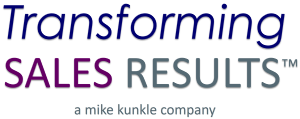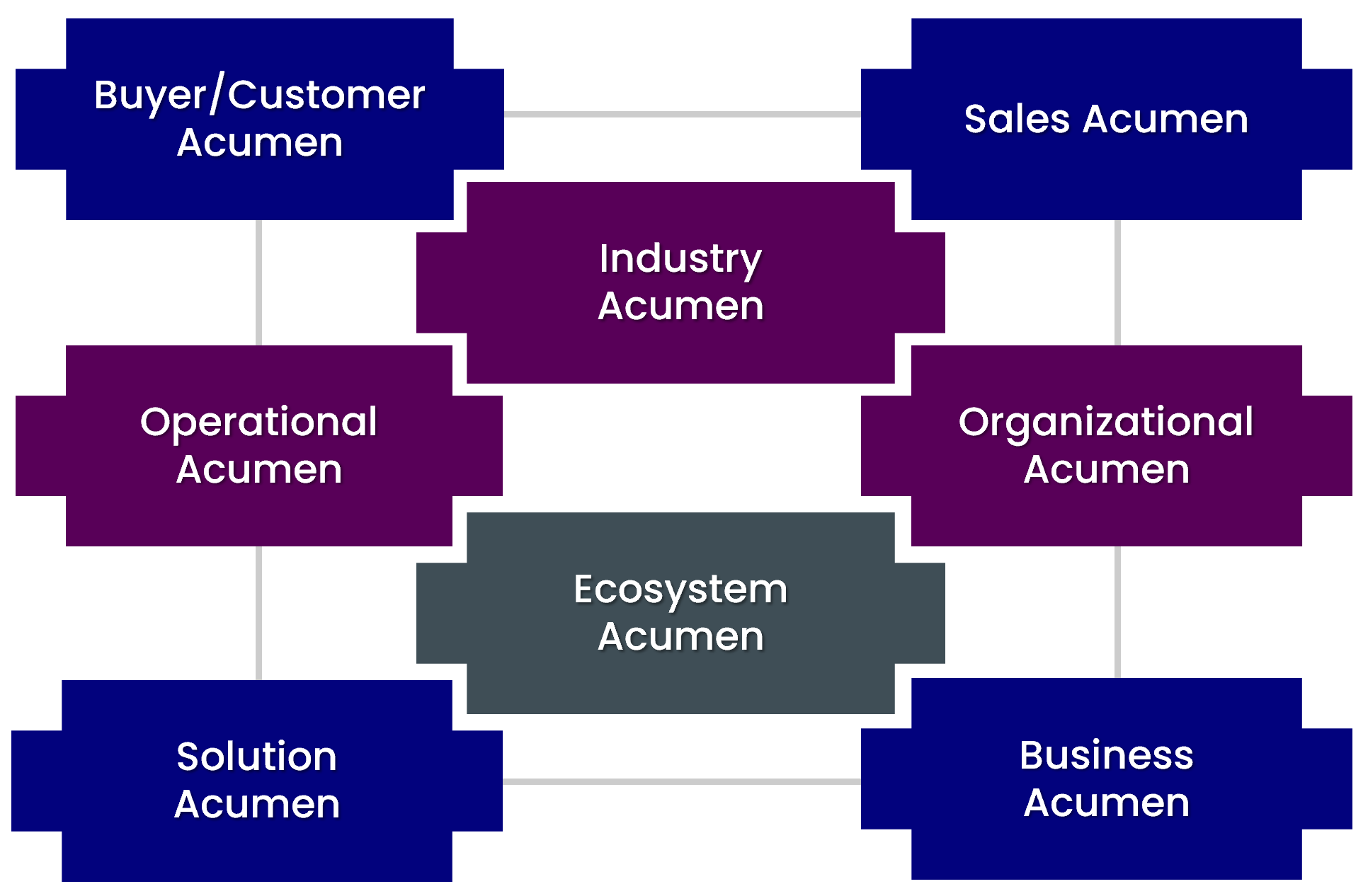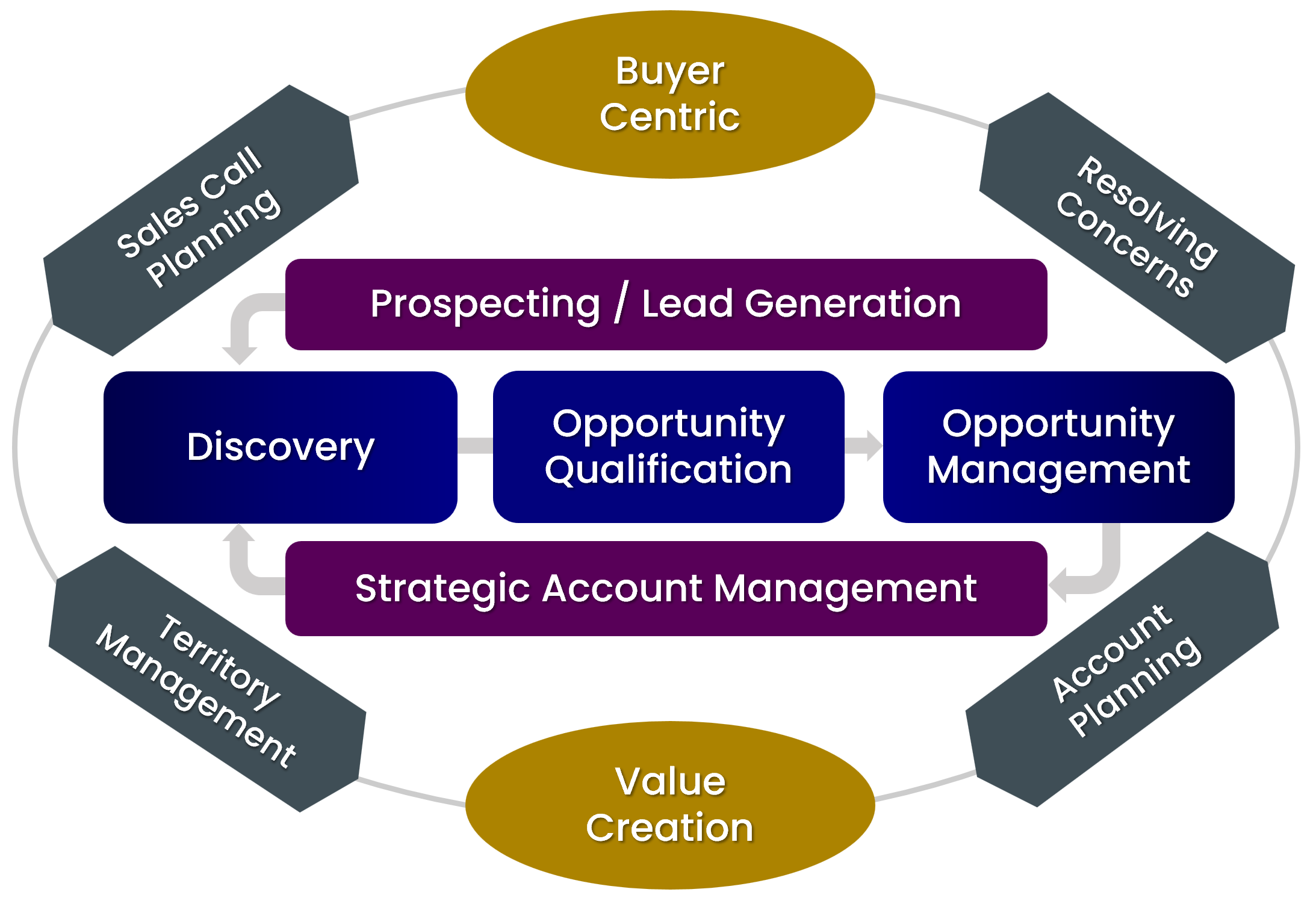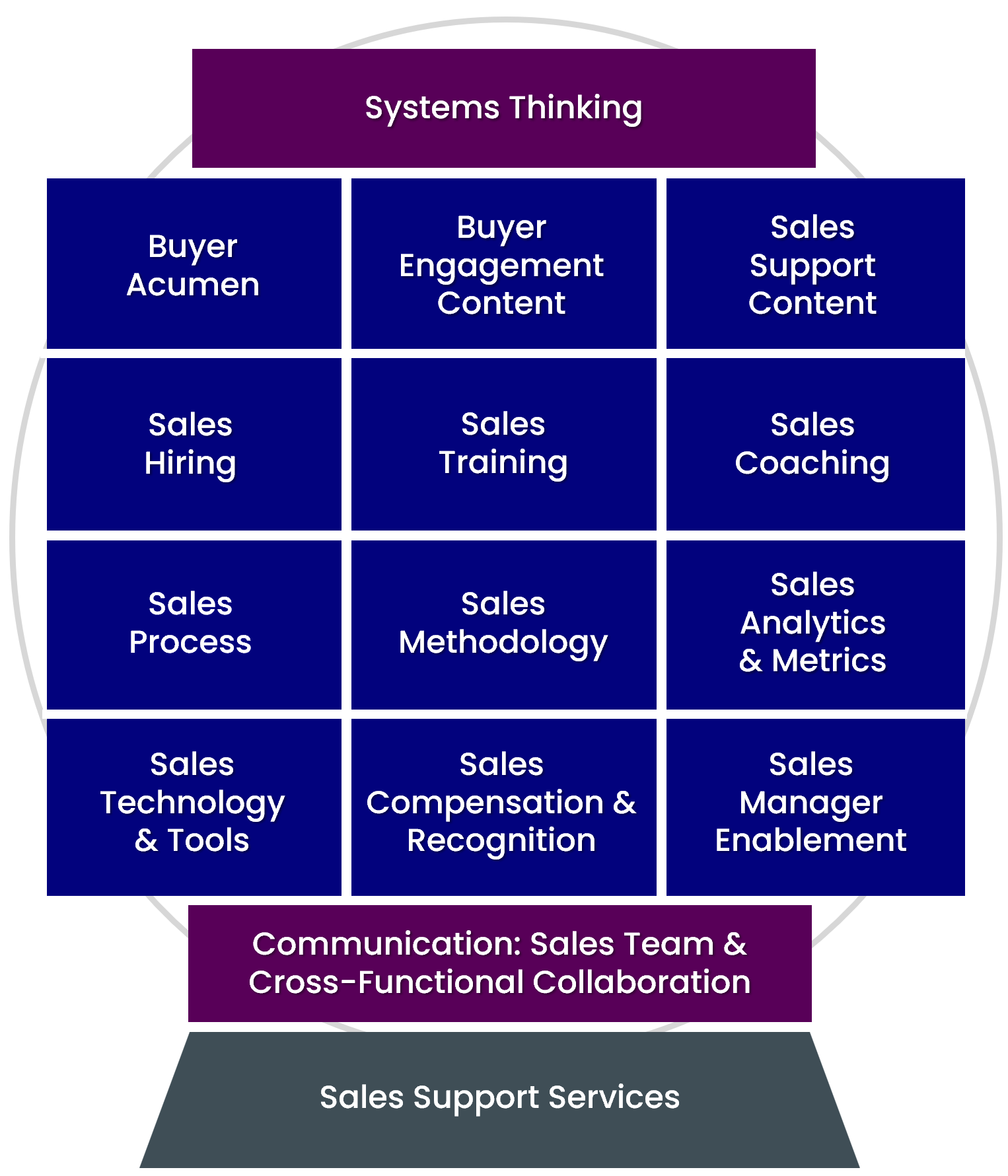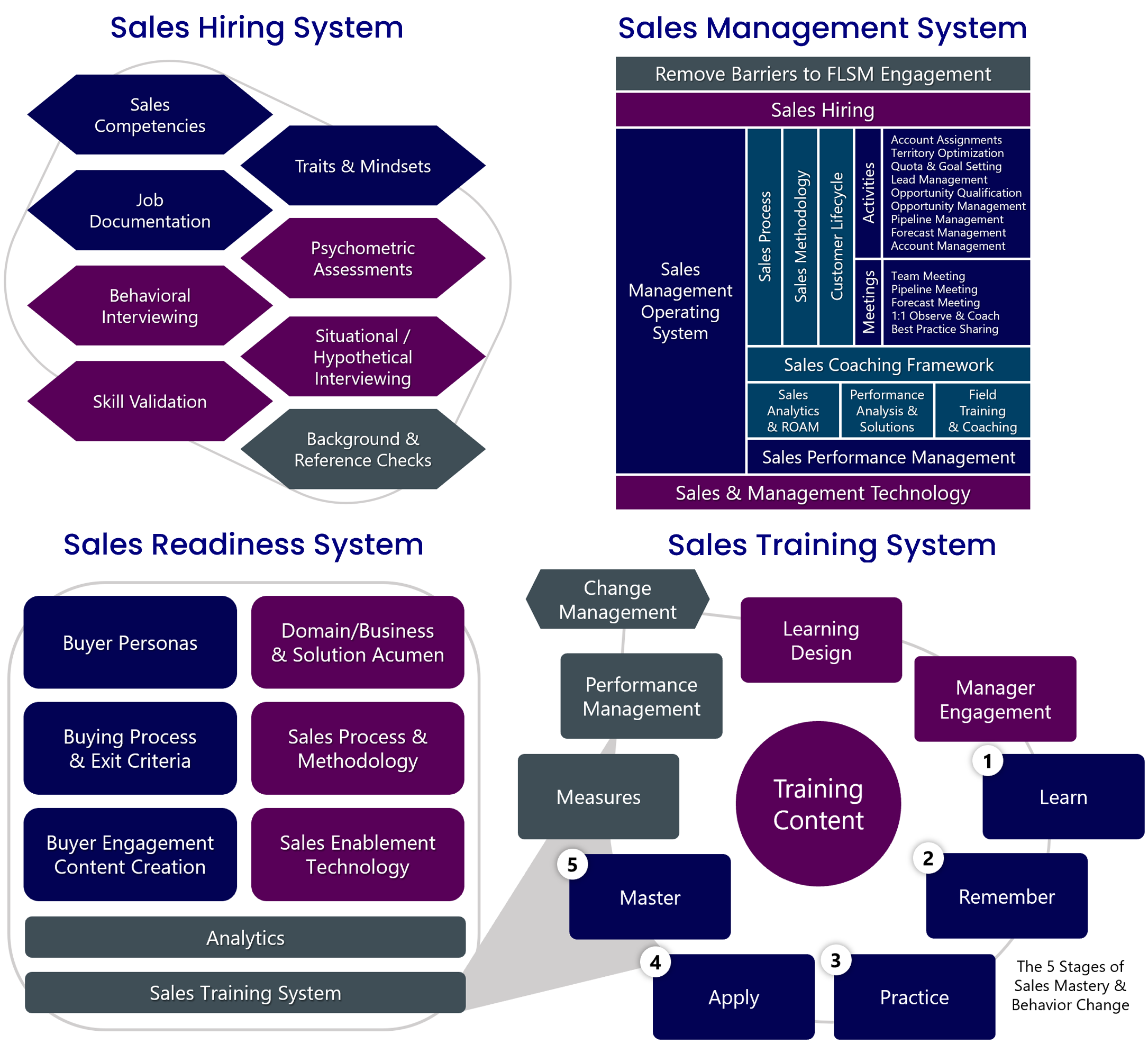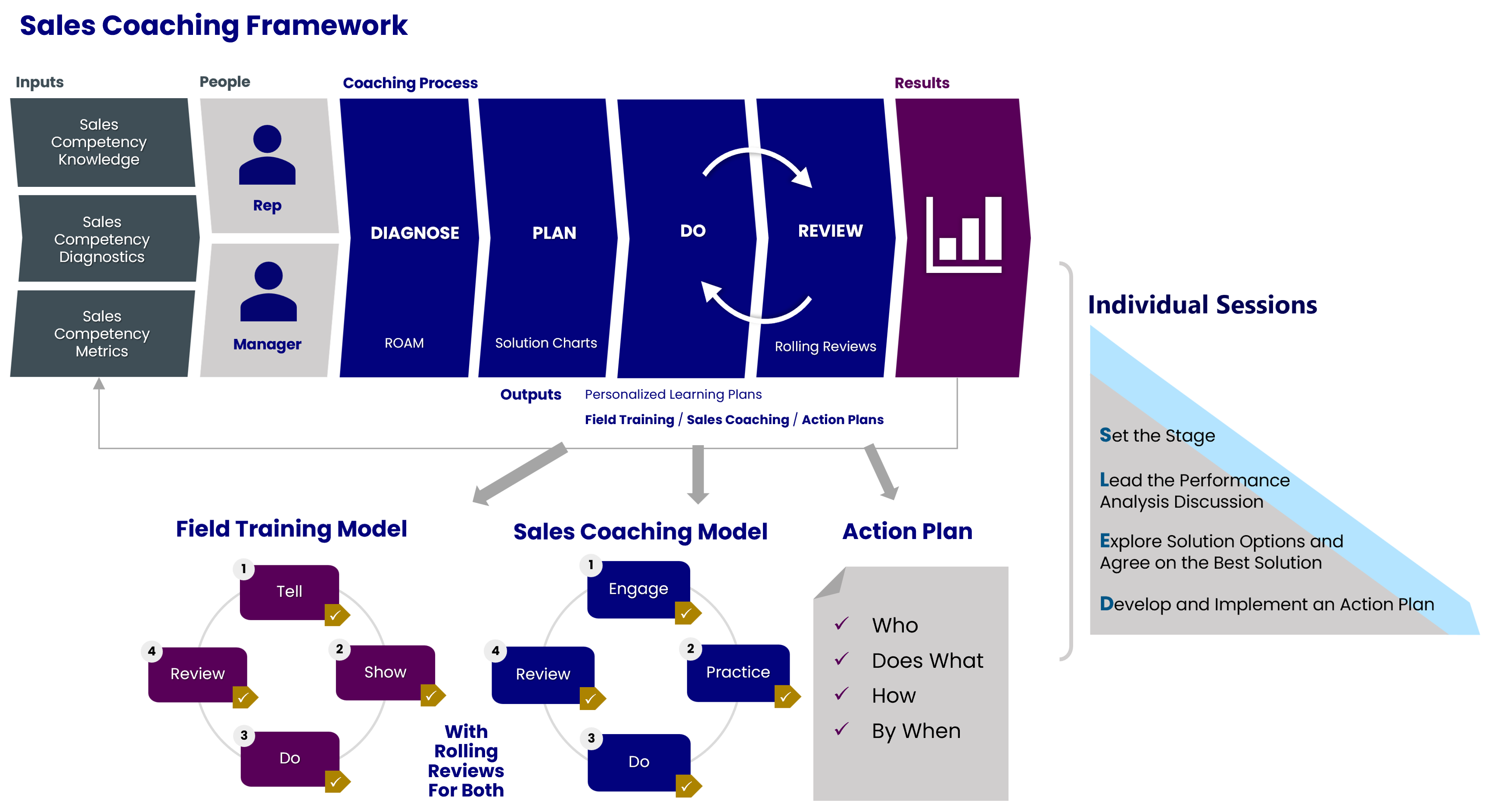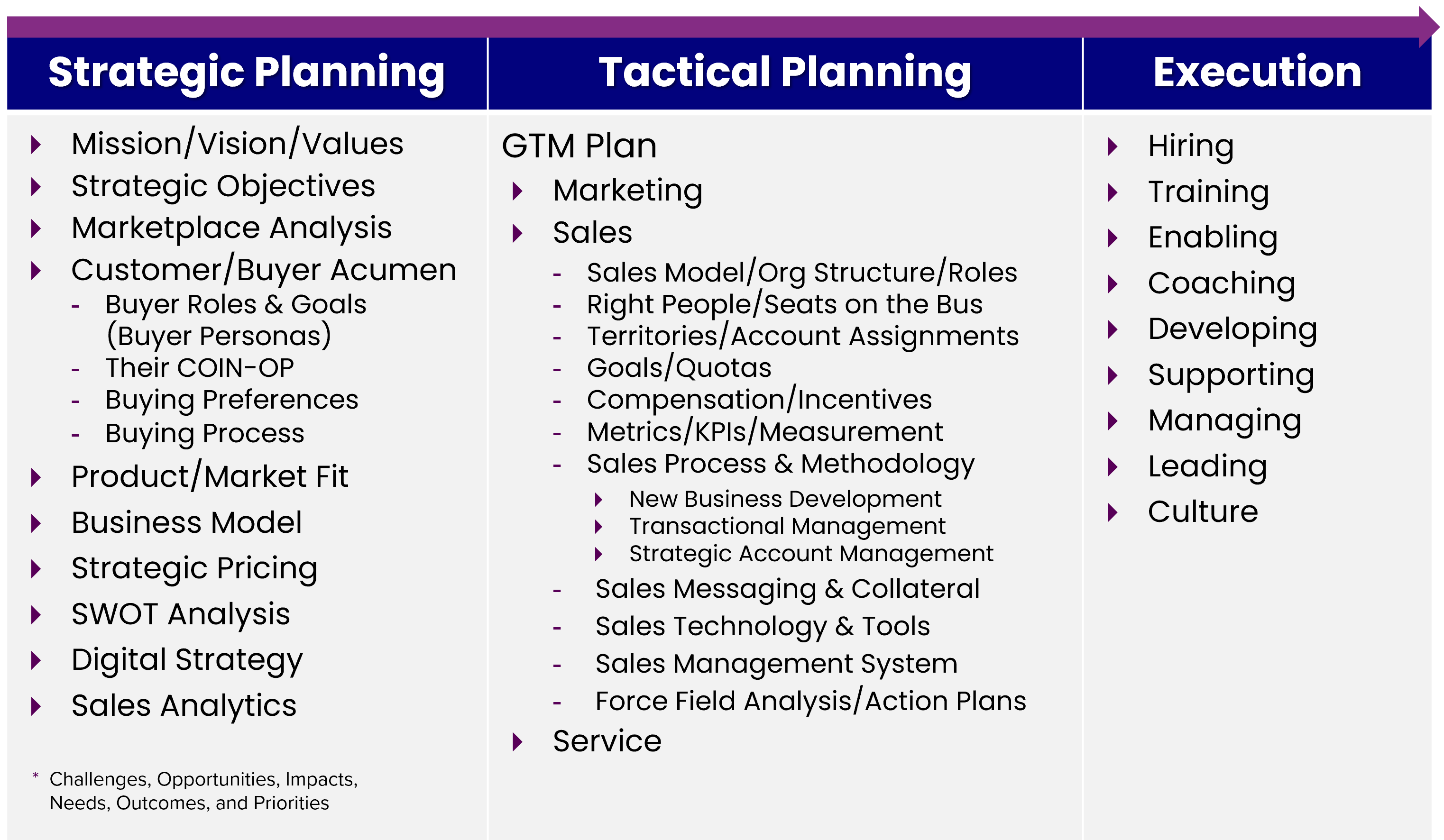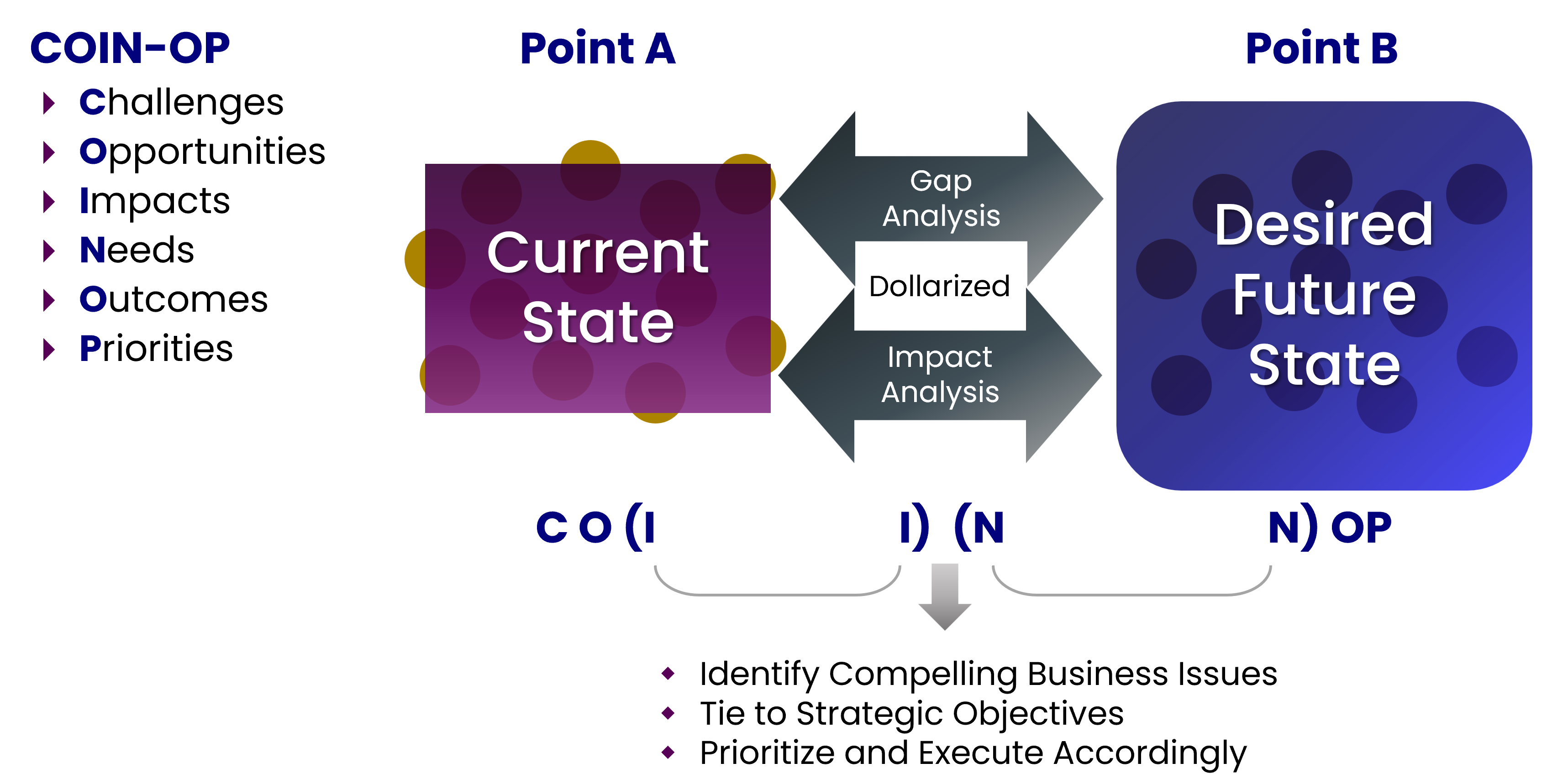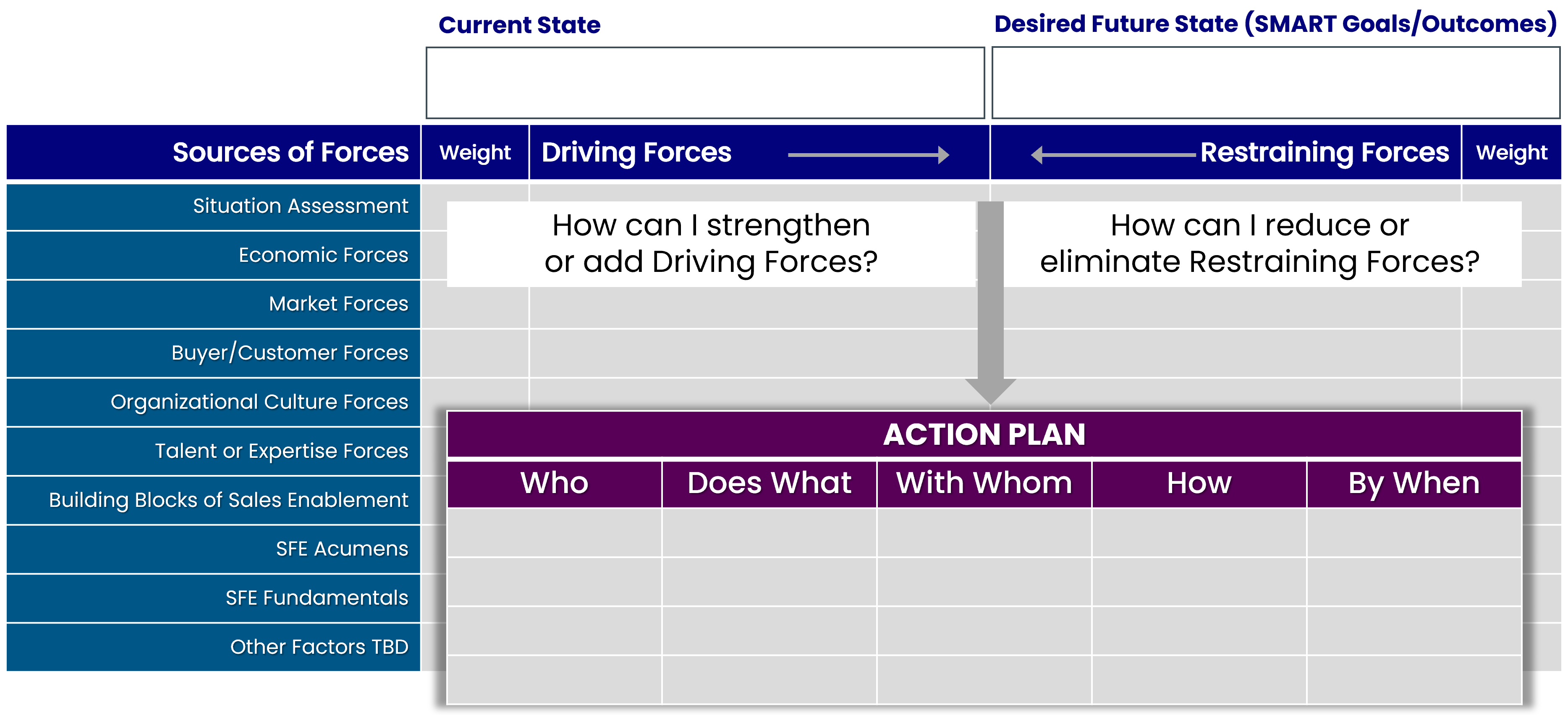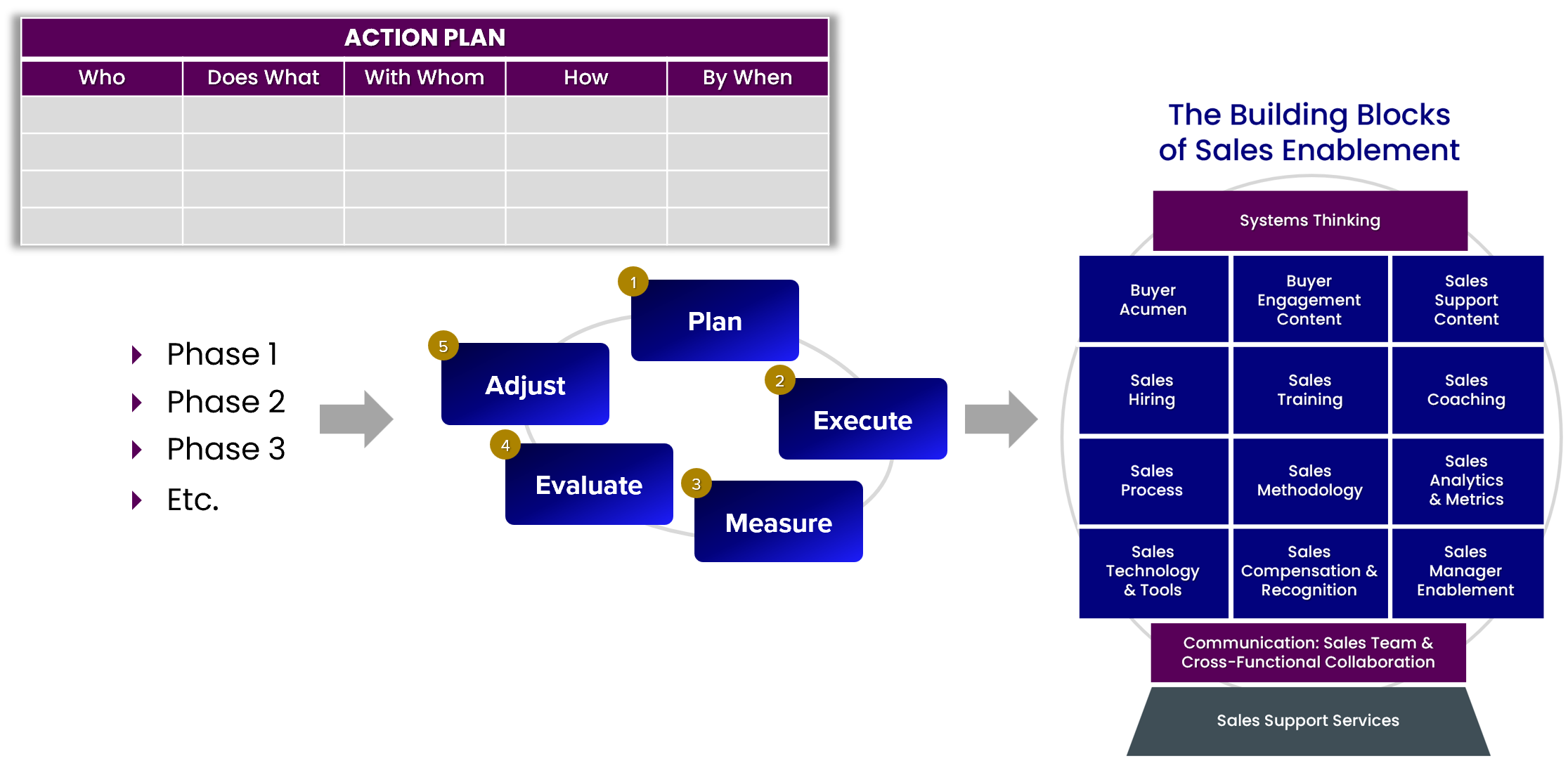The Sliding Scale of Sales Transformation
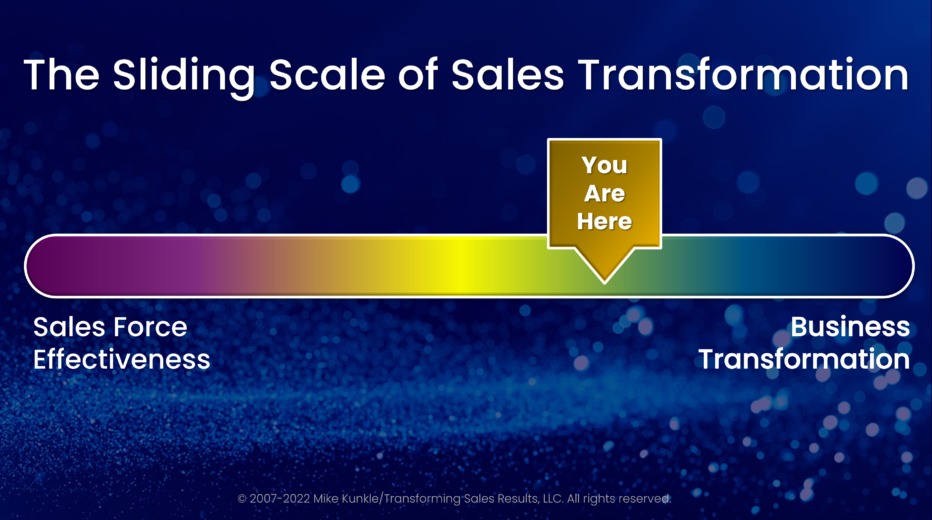
Sales Transformation. It’s a term that means different things to different people.
I’ve been involved in sales transformations that were entirely focused on getting the best-possible performance out of the sales force (ranging from a 30 to 600 percent increase in sales), independent of retooling the rest of the organization. In my experience, the potential for improvement in most sales organizations is significant.
Will an approach limited to sales force effectiveness (SFE) maximize that potential? That depends on a variety of factors, which I will share in this article.
I’ve also been involved in larger business transformations which included the sales force, but encompassed reworking strategy, improving market and buyer acumen, adjusting product-market fit, adapting or fine-tuning business models, reworking sales models, developing new GTM plans, planning for disciplined execution of the changes, and more.
Is this all-encompassing overhaul really required? Again, it depends on the circumstances, and we’ll explore this further, too.
The Elements of Sales Force Effectiveness
Usually, the work performed in the former SFE transformations is also a part of the latter, more comprehensive business transformations. The SFE work itself doesn’t often change. Most business transformations include fine-tuning the sales force, but not all sales transformations require a full business transformation.
Let’s look at and clarify the moving parts of a sales force effectiveness upgrade.
These are the support systems and framework for how to enable and transform sales effectiveness. To start, you’ll want to pay attention to two sales effectiveness frameworks:
- The Sales Force Effectiveness Acumens
- The Sales Force Effectiveness Fundamentals
Figure 1: The Sales Force Effectiveness Acumens
| SFE ACUMENS | DESCRIPTION |
| Buyer/Customer Acumen | Understanding general buyer personas and buyers’ journey or buying processes, including challenges, opportunities, impacts, needs, objectives, priorities (COIN-OP), decision process, decision criteria, decision roles, desired outcomes with metrics and measures, and consideration of both the decision makers’ business and personal needs. |
| Sales Acumen | Includes sales research, sales call planning, prospecting/lead generation, digital selling practices, opportunity qualification, consultative selling using an adaptive sales methodology (including discovery/situation assessment, solution development/co-creating solutions, developing proposals, conducting demos and/or presenting solutions/solution dialogue, resolving concerns, and gaining commitment), sales meeting management, multithreading to message appropriately to buyers with different interests, storytelling, insight selling, negotiating, influence skills, consulting skills, general dialogue and communication skills, team selling, and strategic account management. |
| Business Acumen | Understanding business models, financial acumen, operational metrics, and outcomes such as key performance indicators and critical success factors, pricing, how customer organizations make money, and how to build a business case and calculate ROI. |
| Solution Acumen | Understanding of products and services and how they solve customer problems, critical thinking and problem solving, forcefield analysis, how solutions tie to industry acumen, financial acumen, customer acumen, and ecosystem acumen. This is the culmination of acumens, used to create value for customers (and differentiation for the company) to achieve customers’ desired outcomes. Includes an understanding of competitive offerings and how to position against them, as well as against DIY (do it yourself) and the status quo. |
| Industry Acumen | Domain expertise: understanding the industry challenges, opportunities, technologies, regulations and legislation, business practices, current events and news, and the general state of the profession. |
| Operational Acumen | How to get things done: how to make things happen in your own organization and in others. This includes an understanding of processes, political savvy, culture, collaboration, consensus building, and the ability to execute on all the above plans effectively. |
| Organizational Acumen | How to plan and organize effectively. Includes territory planning, account planning, sales call planning, leading sales meetings, task management, using CRM, sales enablement tools, other technology tools and performance support, action planning, calendaring, project management, change management, and personal productivity practices. |
| Ecosystem Acumen | As applicable, understanding of vendor and channel partners and how to most effectively build relationships and engage with them to uncover, manage, and win opportunities through the effective co-creation of solutions for customers. |
Figure 2: The Sales Force Effectiveness Fundamentals
| SFE FUNDAMENTALS | DESCRIPTION |
| Buyer Centric | Being buyer centric is an outside-in mindset that considers everything you do from the buyers’ perspective and influences your behavior to act in your buyers’ best interest, to achieve your success by supporting their success. |
| Value Creation | Value creation is your ability to understand what each buyer values and co-create solutions to deliver value and communicate the outcomes of your solution to articulate the value you deliver. Value includes Business Value, Experiential Value, Aspirational Value, and Personal Value. |
| Prospecting | Prospecting is the act of researching, planning, and approaching decision maker contacts in target accounts, in such a way to successfully generate interest in exploring how you might help them achieve their goals and setting an appointment to do so. |
| Discovery | Discovery is the act of understanding you buyers’ situation and what matters most to the decision makers and key influencers – their current state and related impacts, their desired future state and related outcomes, and the size of the gap and the urgency to close it. |
| Opportunity Qualification | Opportunity qualification is analyzing various factors of the situation that typically indicate that there is an opportunity (a problem you can solve that is compelling enough to spur action) and that you have a reasonably enough likelihood of winning the business to commit the time, energy, resources, and money to pursue it. |
| Opportunity Management | Opportunity management is the act of purposefully uncovering and satisfying each buyers’ decision criteria and buying process exit criteria, to successful shepherd the opportunity through the stages of the buying and sales process to a final win decision. Negotiating is included here. |
| Strategic Account Management | SAM is the act of analyzing account potential, setting account objectives, considering relationships and other factors to build an account plan that will achieve the pre-set objective, and executing that plan to achieve the objective (usually: grow, maintain, recover). |
| Territory Management | Territory management is the act of analyzing the accounts and potential within your territory, however it is structured, to ensure proper account coverage and to optimize the potential of your territory. |
| Account Planning | Account planning is the act of setting account objectives and creating a plan to achieve them. Part of Strategic Account Management. |
| Sales Call Planning | Sales call planning is the act of setting sales call objectives and then creating a plan to achieve them. |
| Resolving Concerns | Buyers and customers may express various concerns at any stage of the buying process or customer lifecycle. Resolving concerns is the act of following a buyer-centric process to acknowledge and clarify their issues to identify the type of concerns they have, so you can offer relevant perspectives and recommendations to effectively address them. |
In addition, The Building Blocks of Sales Enablement is a framework for better supporting and maximizing performance from a sales force (and the topic of my book by the same name).
Figure 3: The Building Blocks of Sales Enablement
| BUILDING BLOCKS | DESCRIPTION |
| Buyer Acumen | Identify your buyer personas and their COIN-OP (Challenges, Opportunities, Impacts, Needs, Outcomes, Priorities). What problems are buyers trying to solve, what outcomes are they trying to achieve, what are the metrics that matter to each? Includes their typical buying process, including buying process exit criteria. |
| Buyer Engagement Content | Align your marketing content and lead-gen campaigns, sales content/collateral, and sales messaging to identify the problems, share outcomes, and address the buying process exit criteria. |
| Sales Support Content | Develop sales support, job aids, checklists, playbooks, training reminders, calculators, and other tools, to support process/methodology. |
| Sales Hiring | Implement a proven-effective process to hire or promote people who have the best chance of succeeding in the chosen role. |
| Sales Training | Build sales onboarding/ongoing training that supports business objectives. Teach sales process and sales methodology. Develop ongoing training to close sales competency gaps. Train managers then reps. Use a sales training system: Learn, Remember, Practice, Apply, and Master. |
| Sales Coaching | Select a sales coaching model and implement a sales coaching framework. Remove obstacles, enable managers, and engage reps and managers in an ongoing process to identify and close sales competency gaps to increase organizational sales mastery and performance. |
| Sales Process | Align your sales process to the buyer’s journey. Document tasks and exit criteria for buyers and sellers. |
| Sales Methodology | Select appropriate sales methodologies for prospecting, opportunity management, and strategic account management. Develop sales competencies by role from a top-producer analysis whenever possible or proven best practices. Customize as needed. |
| Sales Analytics/Metrics | Benchmark your sales metrics, such as conversion ratios, deal size, cross-sell, ramp-up times for onboarding, sales velocity, content sharing, KPIs – whatever is important for your business. Track results pre-/post-training. Also track your sales onboarding and learning metrics. Analyze everything. Using whatever tools you have available, analyze customers, territories, purchase patterns and more to understand your business and improve performance. |
| Sales Tech/Tools | Select and implement sales technology to support your sales force, create efficiency, and increase time spent selling and support effectiveness. |
| Sales Comp/Recognition | Design a sales compensation plan and incentives, rewards, and recognition that encourage the behaviors you expect and the results you want. |
| Sales Manager Enablement | Train managers to use your sales coaching model. Train managers on performance analysis and coaching. Foster a coaching culture and sales competency development. Determine your sales management operating system / management disciplines you want to instill. Train managers on that and hold them accountable for executing your cadence. |
| Systems Thinking | Apply systems thinking to create an environment that supports high performance. Implement a Sales Hiring System, a Sales Readiness System supported by a Sales Training System, and a Sales Management System, to perpetuate the above building blocks and pull everything together. |
| Communication: Sales Team & Cross-Functional Collaboration | Become the single point of communication for the sales force, with a regular cadence/format. Establish a cadence of communication with cross-functional collaboration partners to review collaboration efforts, progress, results, and revise the plans or charter as needed. |
| Sales Support Services | Provide sales support via SLA for services such as: creating presentations, research, preparation, RFP support, deal desk, coaching support, and more. |
With a sound understanding of the acumens, foundations, and the building blocks, establishing and getting sales systems aligned should be a key part of the transformation effort. Systems thinking plays a large part in SFE tune-ups and upgrades. While there are multiple systems you can adjust, the five systems that I have seen deliver the most consistent results are:
- The Sales Hiring System
- The Sales Readiness System
- The Sales Training System (a subset of the readiness system but important enough to detail, with the Five Stages of Sales Mastery & Behavior Change nested within the training system)
- The Sales Management System
- The Sales Coaching System (a subset of the management system)
Figure 4: The Four Sales Systems
Figure 5: The Sales Coaching System
That’s a lot of information to absorb, isn’t it? The models and visual will help, and as you review them all, you will notice overlap. That’s intentional – all these dots must connect to help you get the best-possible performance from your sales force.
This will help. Here’s how to think about these frameworks to use them effectively.
- The SFE Acumens are the prerequisite things that your sellers need to know and master to maximize their potential.
- The SFE Fundamentals are the things they need to do, as seller, to GTM effectively. Using the foundational acumens, sellers execute the fundamentals.
- The Building Blocks of Sales Enablement is a framework of the things you must do to enable, ready, and support your sales force in achieving their full potential, as they build acumen and execute the fundamentals.
- The Sales Systems are the way that you execute and support the building blocks and your sales force.
As suggested already, whether you need a more comprehensive business transformation or just a transformation related to your sales force’s effectiveness, is contextual and a case-by-case decision.
For the remainder of this article, let’s consider how to determine when each of these approaches is appropriate. We’ll call them “Business Transformation Overhaul” and “Sales Force Effectiveness Upgrade.”
Business Transformation Overhaul
Knowing where to start and what path to follow is a matter of root cause diagnosis, weighed against what you can influence and control inside your organization.
It’s an uncomfortable admission, but the knowing-doing gap in sales leadership is wide, and in sales support functions, there is an equally wide distinction between “doing the right thing” and “doing what’s possible.” If you’re not a CEO, another C-suite executive with political capital and influence, a board member with clout, or a controlling investor, you may not be able to gain support for a full-scale business transformation. This is true whether your organization needs it or not, unless these other leaders recognize the need and are motivated to act. Control what you can, influence the rest, and do the best work possible.
That said, let’s refocus on the need for front-end, root cause analysis. Full training on diagnostic methods is beyond the scope of this article, but we’ll share some helpful ideas. To start, here are some possible indicators that a business transformation is needed.
Note: In the absence of the others, those factors marked with [SFE] indicate the possible need for a sales force effectiveness upgrade.
- Sales productivity (revenue per rep) and/or sales velocity are declining. [SFE]
Figure 6: Sales Velocity
- There’s been a major shift in the competitive landscape, especially with new entrants and modernized business models (such as platforms, partner marketplaces, and communities), that aren’t hampered by legacy business systems or practices.
- You’re experiencing a market disruption, such as being disintermediated by a rise in ecommerce, changes in B2B digital buying behavior, the evolution of technology such as artificial intelligence, machine learning, chat bots, and robotic process automation (RPA), major supply chain disruption, a global pandemic, virtual and digital selling, or shifts in GTM motions.
- Mergers, acquisitions, business unit closures, or strategic divestitures have changed your core business.
- You are behind the curve on implementing business intelligence tools, developing data literacy, and fostering data-driven decision-making.
- Your company or sales force is still more product-focused than buyer- and customer-centric. [SFE, if just the sales force is lagging]
- Ideal customer profiles (ICP), target markets, and buyer personas are non-existent or built from an internal, inside-out perspective, by employees (or a vendor who only interviewed employees).
- Customer churn or defections are high or trending up.
- Customer Acquisition Costs (CAC) are high or climbing. [SFE]
- Net Promoter Scores (NPS), Customer Satisfaction Scores (CSAT), or Customer Effort Scores (CES) are low or trending down.
- Win/Loss Analysis indicates problems not just with how you sell but also a poor sales/buying experience [SFE], and possibly implying poor product-market fit or lack of product competitiveness.
- Demand generation (marketing) efforts are consistently failing to yield enough qualifiable, closable leads.
- Lead generation/outbound prospecting efforts are producing fewer leads and smaller pipelines. [SFE]
- Sellers are not using the content that the marketing department produces, and buyers aren’t getting what they need to make an easy-as-possible buying decision.
- If you have industry benchmark data and your best salespeople don’t move as much product as your key competitors. [SFE]
- If you have identified deficiencies in any of the areas in the first two columns in this table:
Figure 7: Strategy, GTM Tactics, and Execution Chart
As you perform your front-end needs analysis, you can use this chart to conduct gap and impact analyses. Starting in the top left and working down and across, assess each factor.
- How updated and current is each factor?
- Is each at least “good enough for now” (GEFN)?
- Which are missing or need attention?
We could debate the exact order in each column from top to bottom, so recognize that it’s contextual and could vary. Most importantly, the factors in the first column must be acceptable before moving to the second, and the work in that column must be acceptable before moving to the third column.
When you finish, you should have identified any critical gaps. Then, you can assess the impacts of those gaps. As you work:
- Watch for dependences.
- Consider what’s GEFN and what’s missing. A top-priority factor like Buyer/Customer Acumen may be present but not GEFN, and that may be a higher priority than a missing or outdated factor, since everything builds on the foundation of Customer/Buyer Acumen.
- Prioritize by weighing the possible impacts of the gaps compared to the positive outcomes of closing them, which will allow you to build a business case
Remember:
- There is rarely one “right” answer. Nuance and context matter greatly.
- Discuss, share, brainstorm, problem-solve, collaborate cross-functionally, use your best judgment, and decide. Then plan and execute with discipline.
- Seek expert counsel, as needed. Unless you have gained the expertise somewhere along life’s journey, you don’t rewire your house by yourself or replace your own roof. You hire a licensed electrician or roofing contractor. The same applies to sales transformation work.
Keep in mind that focused attention often beats brilliance. A good plan that’s well executed will often win again a great plan that’s poorly implemented. There is some margin for error. Strive for excellence in planning, not perfection. And then execute as brilliantly as possible.
The bottom line? If you can fix your current issues with improved hiring, training, coaching, sales management, or things on the far-right side of this chart and the execution of the other things to the left, you don’t need a full-scale business transformation effort. If you have gaps, you do need a business transformation, or at least some of it. Does every business transformation require reworking everything in the chart? No, it does not. The key is finding the ones that need the most work and prioritizing them, with the above analysis.
Sales Force Effectiveness Upgrade
As mentioned, the factors above marked [SFE] may indicate the need for a sales force effectiveness upgrade (either as part of the business transformation or standalone). In your diagnosis and root-cause analysis, you’ll need to dig deep, “peel the onion,” ask the “5 Whys,” and determine whether there is something deeper behind the reason (other than needing to upgrade how your sales force sells), or whether these deficiencies will be resolved with more effective hiring, sales readiness, training, coaching, process, methodology, content, technology, and management systems, with disciplined execution.
Can you improve sales results even if your product-market fit is not exceptional? Or if you need to rework your sales model and how you go to market? Yes, it’s possible, and even likely. But your results will not be optimal, and ultimately, your company may not survive or thrive long-term without addressing these and other core business issues (especially in the case of disruption or disintermediation). Here are some possible indicators that your issues are just (or mostly) a sales force effectiveness issue.
From above:
- Sales productivity (revenue per rep) and/or sales velocity are declining.
- Customer Acquisition Costs (CAC) are high or climbing.
- Win/Loss Analysis or other diagnostics indicate weaknesses with your sales methodology, such as poor sales/buying experience, lack of deep discovery, product-pitching, focus on features and benefits rather than buyer problems and solutions, not selling consultatively, not demonstrating buyer- and customer-centric behaviors, selling price instead of value (from the buyer’s/customer’s perspective), not building compelling business cases, lack of focus on the buyer’s/customer’s desired outcomes, not establishing account objectives nor building effective account plans to achieve them).
- Lead generation/outbound prospecting efforts are producing fewer leads and smaller pipelines.
- If you have industry benchmark data and your best salespeople don’t move as much product as your key competitors.
New factors to consider:
- You do not have a detailed sales competency model that covers all sales roles.
- New hires are taking too long to ramp-up, aren’t reaching acceptable levels of productivity, and/or first-year turnover is too high or trending up.
- Fewer than 75% of your sellers are achieving quota.
- Your adoption rates for your sales process(es) and sales methodology(ies) are below 75%.
- You do not have an effective, full-cycle sales methodology across the customer lifecycle and a common language to discuss and coach to sales process and sales methodology.
- You have not aligned the buying process of your target market with your sales processes, exhibit poor sales process management, and especially a lack of buying process exit criteria management.
- Your sales force does not possess the equivalent business acumen compared to the personas to whom they sell
- Your sales managers say they do not have the time to coach, do not reinforce the sales training you provide, or do not coach well and consistently.
- Your sellers do not understand how to personalize messaging and value based on the role of the buyer to who they’re speaking.
- Your sellers and managers complain about the lack of tech tools or that the tools that you provide aren’t helping them uncover, open, and win more opportunities, or better manage and grow your current accounts.
- Front-line sales managers are not executing against an effective sales management operating system (a cadence of management activities and team and rep meetings, designed to produce optimal results from their sales team).
That’s quite a list of factors, isn’t it? There’s a happy medium between overcomplicating and oversimplifying, but if you’re going to go deep and get the details right on anything, your front-end gap analysis is the place to do it. Ask yourself, “What on this chart will it take to truly fix this problem or enable this opportunity, starting from the root cause.” Sometimes, just answering that question can be clarifying.
We’ll mention two other tools that will help you as you navigate your business or SFE transformation.
The Situation Assessment Framework
The first tool is a situation assessment framework. At SPARXiQ, we teach this in Modern Sales Foundations as a discovery methodology, but it’s really a consulting framework. It enables you to assess the current state and desired future state determine the gaps and impacts of the status quo or outcomes to be gained by moving to the future state.
Figure 8: Situation Assessment Framework
You can use this Situation Assessment Framework as you conduct your front-end, root cause analysis.
Force Field Analysis
Once you have decided whether you need a full-scale business transformation or a sales force effectiveness transformation, and which factors for either require the most attention (priorities), you can do a force field analysis to create actionable plans to close the identified gaps.
Figure 9: Force Field Analysis
The force field analysis is a tool for root cause analysis that can help you develop actionable plans. It’s as simple as it looks, and far more powerful than it seems at first glance.
Start with your objective and a summary of the current state you’d like to change and the desired future state. If it helps, you can express the future state as SMART goals, but at a minimum, document the outcomes you want to achieve.
On the left, you can list and segment the forces (factors) to assess. We’ve listed some general forces as well as some of the frameworks in this article. Or, you can just start to brainstorm forces. The analysis is only as effective as the forces you capture, so take this step seriously.
On the left, under Driving Forces, document all of the positive forces that are in your favor, pushing you forward toward your desired future state. On the right, list the Restraining Forces that are holding you back (information you need that’s missing would be considered a Restraining Force). It’s helpful to weight forces on both sides. A good force field analysis will expose what is keeping you in equilibrium, in your current state.
Next, you answer two questions to develop actionable plans to achieve your objective, desired future state, and outcomes.
- How can I reduce or eliminate the Restraining Forces (or close information gaps, so you have the data you need to create the most effective plan possible)?
- How can I strengthen or add Driving Forces?
Create and Run Prioritized, Phased Plans
With the analysis done and actions identified, you can create and run phased plans that will activate all of The Building Blocks of Sales Enablement, the Sales Systems that support them, as your sellers go-to-market with foundational SFE Acumens and executing their SFE Fundamentals. As with any critical business initiative, you’ll want to plan, execute, measure, evaluate, and adjust, as needed, to stay on course and achieve your objectives.
Figure 10: Create and Run Prioritized, Phased Plans
Whether you are leading a full-scale business transformation or just the sales force effectiveness upgrade, this approach, with these models, will help you transform your results and maximize the potential of your sales force. And, because you can re-run the process and rework this approach over time, as things change, it will allow you to future-proof your sales force and adapt to whatever that future holds.
Mike Kunkle is a recognized expert on sales training, sales effectiveness, and sales enablement. He’s spent over 26 years helping companies drive dramatic revenue growth through best-in-class training strategies and proven-effective sales transformation systems – and he’s delivered impressive results for both employers and clients. Mike is the founder of Transforming Sales Results, LLC and works as the Vice President of Sales Effectiveness Services for SPARXiQ, where he designs sales training, delivers workshops, and helps clients improve sales results through a variety of sales effectiveness services. Mike collaborated with Doug Wyatt to develop SPARXiQ’s Modern Sales Foundations™ curriculum and also authored the SPARXiQ’s Sales Coaching Excellence™ course. His book, The Building Blocks of Sales Enablement, is available on Amazon.
